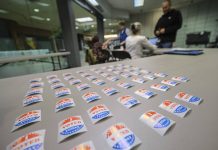Columbus Police are investigating a dozen complaints about counterfeit money being circulated in the city.
The fraudulent currency, which has been primarily $10, $20 and $100 bills, has been discovered already this month at gas stations and fast food restaurants, said Lt. Matt Harris, Columbus Police spokesman.
Many of the fake bills have been of poor quality and have lacked security features that are on real currency, Harris said.
Bills can be held up to the light to look for a holograph on the face image of the bill, and both images should match. For example, if a fake $100 bill has been bleached, the hologram might have an image of Abraham Lincoln, who appears on the $5 bill, instead of Benjamin Franklin.
Looking at a bill through the light also will reveal a thin, vertical strip that has text that spells out a bill’s denomination. The feel and texture of counterfeit money differs from real bills, which can be compared.
Anyone with questions about whether currency is authentic may take the money to their local bank or to a law enforcement agency who can advise whether the bill is real or fake, Harris said.
Anyone with information about counterfeit money being passed in Columbus is asked to call Columbus Police Department Detective Bill Ziegler at 812-376-2627.
Tips and information may be left anonymously.
[sc:pullout-title pullout-title=”How to tell if a bill is fake” ][sc:pullout-text-begin]
Federal officials offer the following among tips to detect counterfeit bills:
- Color-shifting ink: If you hold a new series bill (except the $5 bill) and tilt it back and forth, the numeral in the lower right-hand corner will shift from green to black and back.
- Watermark: Hold the bill up to the light to view the watermark in an unprinted space to the right of the portrait. The watermark should be visible from both sides of the bill since it is not printed on the bill, but is imprinted in the paper.
- Security thread: Hold the bill up to the light to see a thin imbedded strip from top to bottom on the face of the bill. In the $10 and $50 bill, the strip is to the right of the portrait. In the $5, $20 and $100 bills, it is to the left of the portrait.
- Ultraviolet glow: If the bill is held up to ultraviolet light, the $5 bill glows blue, the $10 bill glows orange, the $20 bill glows green, the $50 bill glows yellow and the $100 bill glows red if they are authentic.
- Microprinting: There is tiny microprinting on the security threads within the bills — the $5 bill has “USA FIVE,” the $10 bill has “USA TEN,” the $20 bill has “USA TWENTY,” and the $50 bill has “USA 50.” The $100 bill has “USA 100” on the security thread. The microprinting is near the portrait as well as on the security threads.
- Fine line printing patterns: Very fine lines have been added behind the portrait and on the reverse side scene to make the bill difficult to counterfeit
- Compare: Compare the feel and texture of a real bill with one you suspect is fake.
[sc:pullout-text-end]




